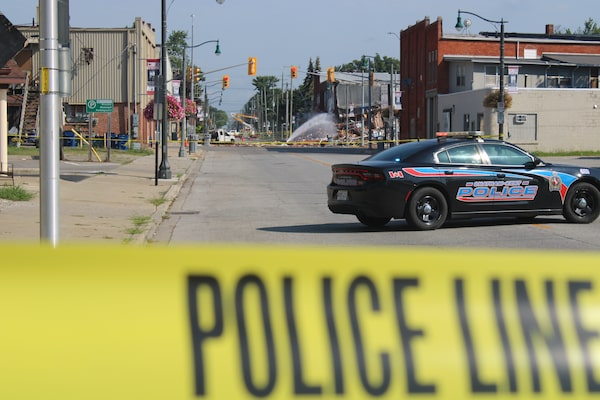
Firefighters pour water on the scene of the explosion in Wheatley, Ont. on Aug. 27, 2021.Colin Graf/The Globe and Mail
Rubble is all that’s left of a downtown landmark that once housed an Irish pub in Wheatley, Ont., and dangerous gas is still being detected after an explosion flattened the building and injured 20 people.
The Thursday evening blast left the community on edge, as municipal officials warned Friday that the risk of another explosion remained high and called on the province to take immediate action.
With monitors around the perimeter of the evacuated site continuing to detect gas, Chatham-Kent Fire Chief Chris Case said in a statement Friday it was still too dangerous to enter the area.
The provincial government said the Ontario Fire Marshal is working with the Chatham-Kent Fire Department to investigate the cause of the explosion, which local and provincial officials believe was a century-old gas well.
The blast was close to a location where hydrogen sulphide gas was first discovered in June, prompting an evacuation order and the declaration of a state of emergency. Hydrogen sulphide is extremely flammable and highly toxic to humans, even at low concentrations. Effects range from headaches to unconsciousness and death.
The municipality said provincial inaction is putting the lives of residents and first responders at risk, and wants the province to do more.
“It is unacceptable for the people of Wheatley to live in fear,” said Chatham-Kent Mayor Darrin Canniff.
People from the town of around 3,000 gathered at police tape Friday, trying to catch a glimpse of the blast site as firefighters poured water on the rubble. One man drove a utility vehicle to bring water and other drinks to the emergency crews at the site on a scorching 30-degree day.
Officials were first called to the scene at around 4:30 p.m. Thursday, when gas monitoring devices at the site set off an alarm. First responders had cleared the buildings and were in the process of evacuating when the explosion occurred. One person injured in the blast remained in hospital Friday.
Whit Thiele, who owns the building destroyed in the explosion, told The Globe and Mail Friday he discovered the initial leak in June after a foul smell permeated the building.
As he searched the basement, the smell became stronger and a low hiss began. He recounted hearing a deep rumble before water and sludge started rising up into the basement from “every crack, every nook.” Calling the experience “horrifying,” he said he also saw puddles of rain water behind the building “bubbling like champagne.”
He fled the building with a friend and called 911. After receiving oxygen from EMS, they were told the gas could have killed them.
In July, the municipality declared a second state of emergency after confirming hydrogen sulphide was once again present in the building in the centre of town. That state of emergency remained in effect.
Ontario’s Ministry of Northern Development, Mines, Natural Resources and Forestry told The Globe in an e-mail it has been working with a consultant since early August to determine the source of the leak and provide 24-hour monitoring.
Experts who have studied emissions from thousands of orphaned oil and gas wells scattered around Southern Ontario say the province must figure out the cause of the leak or risk more incidents, including possible explosions.
Mary Kang, an assistant professor at McGill University, specializes in greenhouse gas emissions related to oil and gas development.
Dr. Kang recently measured emissions from wells further east, in Norfolk County, but says those numbers are “just a drop in the bucket” when it comes to the scale of the legacy well problem facing the province.
“People now think of Texas and Alberta when they think of oil,” she said in an interview, but the first oil well was drilled in Ontario in 1858.
“If the well was drilled in the 1800s, I don’t think much explanation is needed for why they probably weren’t recorded properly, why no responsible party no longer exists, and why they may not have been abandoned to modern standards.”
Without taking specific measurements, she said, the number, age and condition of orphaned wells in the province makes it tough to know whether and how much a well is leaking, let alone if it will explode.
“If you were to ask me, ‘Could this happen again then?’ I would say yes, of course it could happen again,’” Dr. Kang said.
“I just don’t know when and where. No one does.”
University of Waterloo adjunct professor Richard Jackson has also studied methane and hydrogen sulphide leaks from legacy gas wells in southwestern Ontario, and told The Globe their condition poses a significant risk.
“If there’s any steel left in them, it’s corroding. If there’s any cement in them, it’s deteriorating,” he said.
“If you don’t fix a problem, it’s going to get worse. And that’s the problem with these old wells – it’s getting worse all the time.”
Last year, the federal government announced $1.7-billion to clean up orphaned and inactive wells in Alberta, Saskatchewan and B.C. In response, the Ontario Petroleum Institute asked Ottawa for $270 million to reclaim the thousands of orphan wells that pose environmental and safety hazards in that province.
With a report from The Canadian Press
Our Morning Update and Evening Update newsletters are written by Globe editors, giving you a concise summary of the day’s most important headlines. Sign up today.
 Emma Graney
Emma Graney